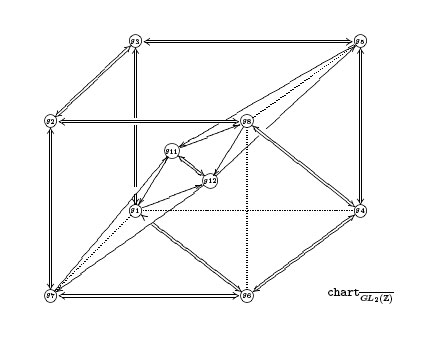Now, can
we assign such an non-commutative tangent space, that is a  for some quiver Q, to
for some quiver Q, to  ? As
? As  we may
we may
restrict any solution 
in  to the finite subgroups
to the finite subgroups  and
and  . Now, representations of finite cyclic groups are
. Now, representations of finite cyclic groups are
decomposed into eigen-spaces. For example

where  with g the
with g the
generator of  . Similarly,
. Similarly,

where  is a
is a
primitive 3-rd root of unity. That is, to any solution  we have found 5 vector spaces
we have found 5 vector spaces  and
and  so we would like them to correspond to the vertices
so we would like them to correspond to the vertices
of our conjectured quiver Q.
What are the arrows of Q, or
equivalently, is there a natural linear map between the vertex-vector
spaces? Clearly, as

any choice of two bases of V (one
compatible with the left-side decomposition, the other with the
right-side decomposition) are related by a basechange matrix B which we
can decompose into six blocks (corresponding to the two decompositions
in 2 resp. 3 subspaces

which gives us 6 linear maps between the
vertex-vector spaces. Hence, to  does correspond in a natural way a
does correspond in a natural way a
representation of dimension vector  (where
(where  ) of the quiver Q which
) of the quiver Q which
is of the form
![\xymatrix{ & & & &
\vtx{b_1} \\ \vtx{a_1} \ar[rrrru]^(.3){B_{11}} \ar[rrrrd]^(.3){B_{21}}
\ar[rrrrddd]_(.2){B_{31}} & & & & \\ & & & & \vtx{b_2} \\ \vtx{a_2}
\ar[rrrruuu]_(.7){B_{12}} \ar[rrrru]_(.7){B_{22}}
\ar[rrrrd]_(.7){B_{23}} & & & & \\ & & & & \vtx{b_3}} \xymatrix{ &
& & & \vtx{b_1} \\ \vtx{a_1} \ar[rrrru]^(.3){B_{11}}
\ar[rrrrd]^(.3){B_{21}} \ar[rrrrddd]_(.2){B_{31}} & & & & \\ & & & &
\vtx{b_2} \\ \vtx{a_2} \ar[rrrruuu]_(.7){B_{12}} \ar[rrrru]_(.7){B_{22}}
\ar[rrrrd]_(.7){B_{23}} & & & & \\ & & & & \vtx{b_3}}](http://www.math.ua.ac.be/~lebruyn/latexrender/pictures/
26a8254b3e45806da1b86a09e0fb0c95.gif)
Clearly, not every representation of  is obtained in this way. For starters, the
is obtained in this way. For starters, the
eigen-space decompositions force the numerical restriction

on the
dimension vector and the square matrix constructed from the arrow-linear
maps must be invertible. However, if both these conditions are
satisfied, we can reconstruct the (isomorphism class) of the solution in
 from this quiver representation by taking
from this quiver representation by taking


Hence, it makes sense to
view  as a linearization of, or as a tangent space to,
as a linearization of, or as a tangent space to,
 . However, though we reduced the study of
. However, though we reduced the study of
solutions of the polynomial system of equations to linear algebra, we
have not reduced the isomorphism problem in size. In fact, if we start
of with a matrix-solution 
of size n we end up with a quiver-representation of total dimension 2n.
So, can we construct some sort of non-commutative normal space to the
isomorphism classes? That is, is there another quiver Q whose
representations can be interpreted as normal-spaces to orbits in certain
points?
